Athletes must optimize every part of their bodies to achieve peak performance. When it comes to vision, even the slightest improvement in an athlete’s visual range, processing speed, and clarity can help get them a competitive advantage in their sport. A recent study reports that including dietary carotenoids like lutein and zeaxanthin supplements can help enhance the macular pigments in the eyes, protect against atmospheric haze, and improve visual range. In this article, we discuss the published study in detail and also delve into the best food sources of lutein and zeaxanthin.
Before we dive deep into the study, here is our top vision health article
Ocular health is important to maintaining one’s quality of life and staying healthy and independent.
Across the world, about 250 million people have different degrees of vision problems.
Age, lifestyle changes, imbalanced diet, metabolic disorders, and eye trauma are all reasons that can cause vision loss.
For athletes, good vision is extremely vital.
Athletes need perfect vision beyond the recommended 20/20 eyesight.
Factors like depth perception, focal flexibility, visual reaction time, and dynamic visual acuity (the ability to distinguish shapes and features from a distance) are essential for athletes to excel at their sport.
Sports optometrists are specialized experts who design strategies to help athletes care for their ocular health and improve vision.
One of the main areas of focus for sports optometrists is the right nutrition.
Various macro and micronutrients play a role in protecting the eyes and preventing the signs of age-related and environmental damage to the eyes.
Plant-based carotenoids, especially, play a vital role in protecting eye health.
Carotenoids are pigments that give plant and animal food sources their color.
Two main carotenoids of interest in vision health in athletes are lutein and zeaxanthin.
Lutein is a type of carotenoid found in plant and animal food sources.
Lutein may help prevent oxidative damage, reduce glare impairment, and enhance vision sharpness.
Lutein is majorly found in green leafy vegetables like kale, collards, and spinach and yellow-colored flowers and vegetables.
Zeaxanthin is also a type of carotenoid that supports eye health.
This carotenoid acts as a filter, blocking harmful UV rays from damaging the eyes.
Oranges, grapes, mangoes, orange peppers, goji berries, and corn are some zeaxanthin sources.
A 2023 study published in the Exercise and Sport Sciences Reviews journal analyzed the importance of nutrition in improving the vision of athletes.
This study focused on lutein and zeaxanthin components and their help in building up the macular pigments in the eye.
Macular pigments are like internal sunglasses for the eyes.
These are located in the central retina and comprise three dietary carotenoids - lutein, zeaxanthin, and meso-zeaxanthin.
These pigments filter out blue light and decrease the effects of light scatter, both of which can lead to vision damage and Age-related Macular Degeneration (AMD).
Macular Pigment Optical Density (MPOD) is a measure of the density of the macular pigment.
Higher levels of MPOD would help protect and improve vision.
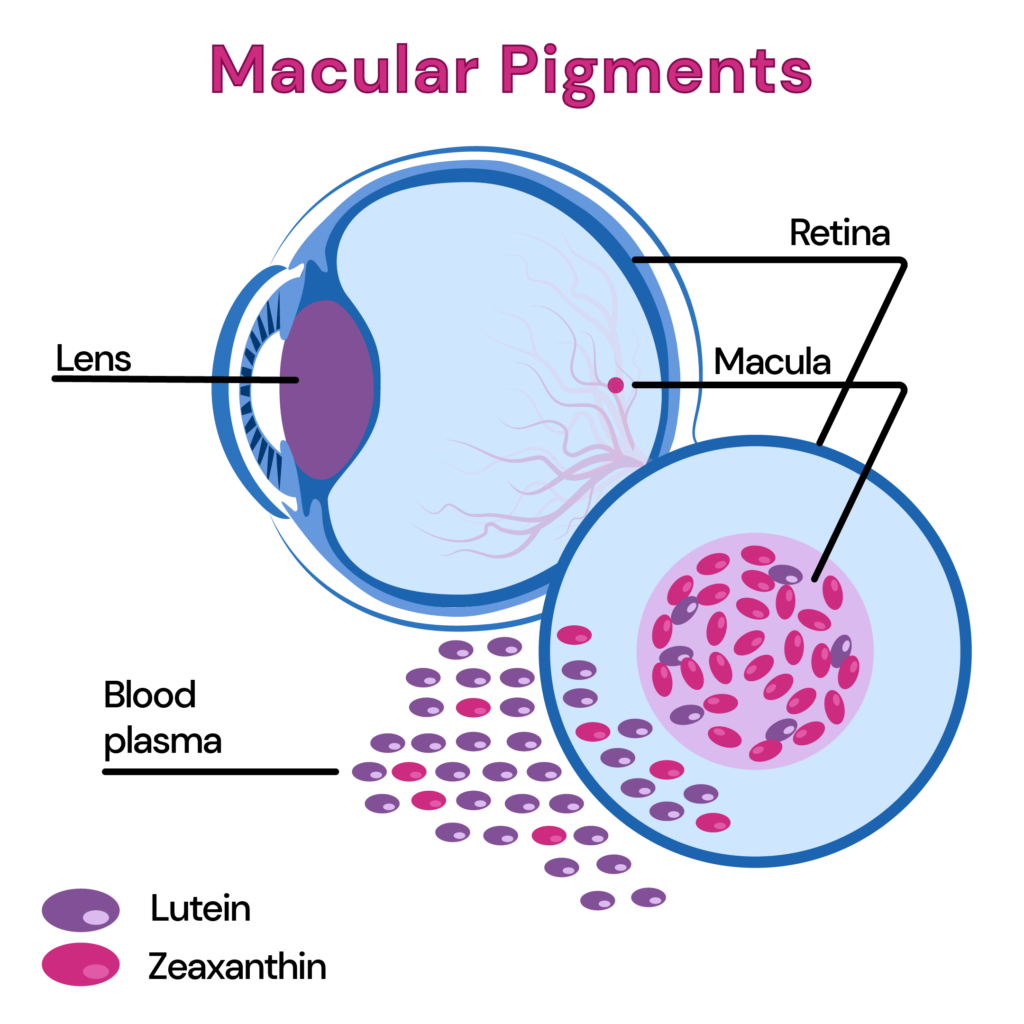
This study focused on two significant ocular challenges that athletes face - low visual range and atmospheric haze.
Visual range is the maximum distance the viewer can see unobstructed and clear images with unaided eyes.
Atmospheric haze is environmental obstructions like dust, haze, smoke, or dirt that can disrupt vision and create a bluish or brownish tint to the view.
This study reports that improving dietary carotenoid intake can help increase MPOD.
High MPOD can enhance the visual range and protect against atmospheric haze.
Multiple older studies support this observation.
A 2012 study analyzed the effects of lutein and zeaxanthin on the visual performance of athletes.
The study reports that these carotenoids may help athletes in the following ways.
Another study conducted in 2013 reported that lutein and zeaxanthin affected the visual and motor regions in the Central Nervous System and improved visual motor responses.
In 2014, a double-blind, placebo-controlled study analyzed the effects of lutein and zeaxanthin on neural processing speed. The study reported that these carotenoids helped increase visual processing speed in individuals across different age groups.
According to this study, even the slightest improvement in visual ability can be advantageous to athletic performance.
Athletes often focus on protein-rich foods to match their activity levels.
Along with that, a diet plan rich in carotenoids will help improve brain and retinal levels of lutein and zeaxanthin.
Lutein and zeaxanthin can help improve cognitive and visual performance in athletes.
These carotenoids can also protect athletes from eye problems like actinic eye and AMD.
Lutein can be converted into meso-zeaxanthin in the body.
That’s why scientific sources mention foods containing lutein and zeaxanthin as a single category.
The following are some of the best food sources of lutein and zeaxanthin.
| Food sources | µg/g fresh weight |
| Basil | 70.5 |
| Parsley | 64.0–106.5 |
| Spinach | 59.3–79.0 |
| Leek | 36.8 |
| Peas | 19.1 |
| Broccoli | 7.1–33.0 |
| Carrot | 2.5-5.1 |
Table source: https://www.ncbi.nlm.nih.gov/pmc/articles/PMC3705341/table/nutrients-05-01169-t001/?report=objectonly
While most grains have negligible sources of lutein and zeaxanthin, durum wheat and einkorn are two sources of grain rich in carotenoids.
https://www.ncbi.nlm.nih.gov/pmc/articles/PMC10259207/
https://pubmed.ncbi.nlm.nih.gov/24148268/
https://pubmed.ncbi.nlm.nih.gov/23053558/
https://www.ncbi.nlm.nih.gov/pmc/articles/PMC4176961/
https://www.aoa.org/healthy-eyes/caring-for-your-eyes/diet-and-nutrition?sso=y
https://www.ncbi.nlm.nih.gov/pmc/articles/PMC6771137/
https://www.aao.org/eye-health/tips-prevention/diet-nutrition
https://www.ncbi.nlm.nih.gov/pmc/articles/PMC3725486/
https://www.ncbi.nlm.nih.gov/pmc/articles/PMC3705341/
https://www.sciencedaily.com/releases/2023/06/230608120930.htm
Imagine a life where you feel like you're in a constant battle against sleep. If you find yourself plagued by uncontrollable sleep attacks and a constant feeling of tiredness, you might be aware of the condition called “narcolepsy.” This article aims to explore the science behind this condition and answer the question, “Is narcolepsy genetic?” Further, it also touches upon how you can evaluate your genetic risk for narcolepsy and how to manage excessive sleepiness.
Many sleep parameters like sleep duration, sleep quality, and chronotype and sleep disorders like snoring, obstructive sleep apnea, and narcolepsy have a genetic component to them. Here’s how you can learn your genetic risk.
Narcolepsy is a neurological sleep disorder that can cause excessive daytime sleeping and sudden sleep attacks.
People with narcolepsy have intense urges to fall asleep at random times, like eating or driving.
According to Narcolepsy Network, one in every 2000 Americans is diagnosed with narcolepsy.
Across the world, about three million individuals are affected by the condition.
However, according to experts, only 25% of patients with this condition get diagnosed and treated.
So the total population living with the condition could be much higher.
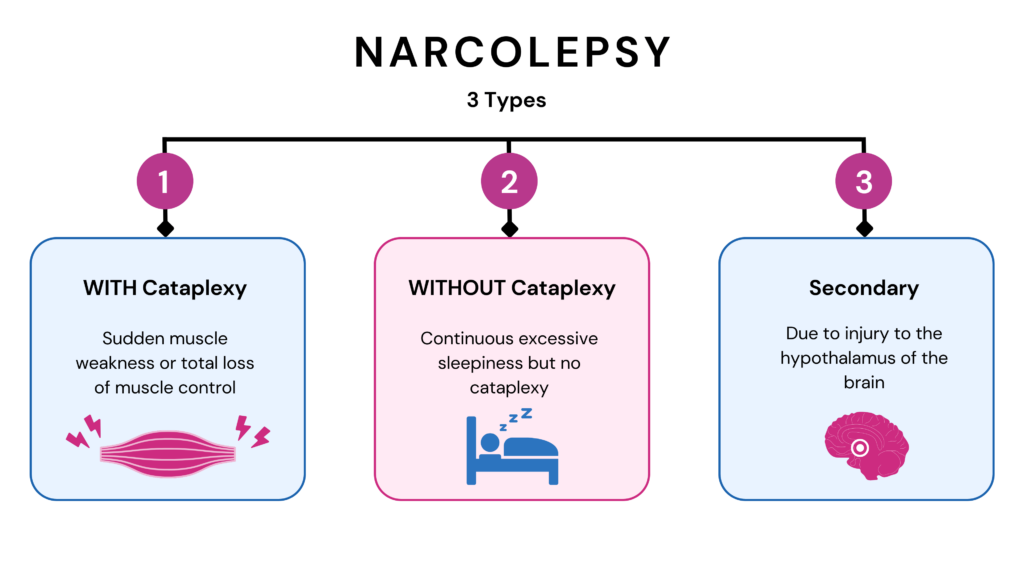
There are three types of narcolepsy identified.
Type 1 Narcolepsy
Type 1 narcolepsy is also called narcolepsy with cataplexy.
Cataplexy is a condition that causes loss of control of muscles or muscle weakness due to a strong emotion like surprise or anger.
These individuals have low levels of the brain hormone termed hypocretin and experience sleep paralysis and excessive daytime sleepiness.
Type 2 Narcolepsy
Type 2 narcolepsy is narcolepsy without cataplexy.
These individuals don’t experience cataplexy and sleep paralysis and have normal hypocretin levels.
While they still experience sleep paralysis, the symptoms are less severe.
Secondary Narcolepsy
Secondary narcolepsy results from an injury to the hypothalamus region in the brain.
The hypothalamus region of the brain helps regulate sleep.
The symptoms of secondary narcolepsy could be very similar to type 1 or type 2 narcolepsy.
Here are five common signs of narcolepsy.

The following are some of the common risk factors for developing narcolepsy.
While narcolepsy can be diagnosed at any age, the symptoms commonly start in adolescence, between the ages of 7 and 25.
A family history of narcolepsy increases the risk of developing the condition by 20-40%.
In the case of type 1 narcolepsy, certain autoimmune disorders may be a risk factor.
Some autoimmune disorders may affect the brain cells and decrease the production of the hormone hypocretin, leading to sleep disorders like narcolepsy.
People with brain injuries have a higher risk of developing secondary narcolepsy.
A combination of genetic changes and environmental triggers leads to narcolepsy.
The risk factors mentioned above can increase a person’s probability of developing the condition.
Genetic mutation is undoubtedly a factor that can cause narcolepsy.
Gene mutations, along with specific environmental triggers like infections, can lead to the development of this condition.
TNFSF4 gene (TNF Superfamily Member 4 gene)
The TNFSF4 gene contains instructions to produce a protein that plays a role in the immune function.
Certain changes in this gene can result in increased levels of the immune system protein.
When this happens, the excess immune cells can attack the brain cells that produce hypocretin, an important regulator of sleep-wake cycles.
This can result in an increased risk of narcolepsy.
CCR1/CCR3 gene (C-C motif) receptor 1/C-C motif) receptor 3 gene)
The CCR1/CCR3 gene is responsible for the production of chemokines that play a role in the inflammatory response in the body.
Chemokines are signaling proteins that stimulate the movement of white blood cells and immune responses.
Changes to the inflammatory responses can increase narcolepsy risk.
CPT1B gene ( Carnitine Palmitoyltransferase 1B gene)
CPT1B is a gene that plays a role in beta-oxidation in the body. This is a 4-step process that helps break down fatty acids.
Research suggests that fatty acid oxidation is increased during sleep, and mutations in fatty acid metabolism alter REM sleep.
This way, certain changes in the CPT1B gene can influence the risk for narcolepsy.
According to the National Institute of Neurological Disorders and Stroke, about 10% of people with type 1 narcolepsy may have close relatives with similar symptoms.
About 1-2% of the population inherit the condition from their ancestors.
Can I pass narcolepsy to my child?
According to experts, in rare cases, narcolepsy may be inherited across generations.
However, most cases occur randomly and are not passed on.
Is narcolepsy something you're born with?
Some individuals may be born with certain gene mutations that affect hypocretin production in the brain, causing narcolepsy.
In most cases, damage to these hypocretin-producing brain cells may occur randomly due to environmental triggers, leading to the condition.
Genetic testing may identify a person’s risk for type 1 narcolepsy.
A blood test can help find out whether you have genetic markers associated with narcolepsy.
A positive result supports a diagnosis but does not make it 100% certain
Many people without narcolepsy also have these genetic markers.
Certain direct-to-consumer genetic companies also help analyze your already existing DNA data to check several markers linked to narcolepsy risk.
Here's how you can still get your narcolepsy report
Narcolepsy cannot be cured and can only be managed with the right treatments.
The following drugs are common options for narcolepsy management.
Stimulant Drugs - stimulant drugs stimulate the nervous system and help prevent excessive daytime sleepiness. Common stimulants include sodium oxibate, pitolisant, and modafinil.
SNRIs And SSRIs - Serotonin and Norepinephrine Reuptake Inhibitors (SNRIs) and Selective Serotonin Reuptake Inhibitors (SSRIs) are medicines used to suppress the sleep REM cycle and handle the symptoms of narcolepsy.
TCAs - Tricyclic Antidepressants (TCAs) can help handle cataplexy but come with possible side effects. So discuss with your doctor before choosing TCAs.
Creating good sleeping habits like the following may help handle the condition well.
The main problem people with narcolepsy have is excessive sleepiness in the daytime.
A trick to managing this is taking scheduled naps of 20-30 minutes throughout the day to stay awake during the other times.
A 2018 study reports that physical activity improves night-sleep duration, reduces the frequency of day naps, and enhances the quality of sleep in narcolepsy type 1 patients.
Do you always reach out to fast food or packaged snacks and desserts when you feel down? You are not alone. A majority of the population finds comfort in emotional eating to handle stress.
Researchers now believe that stress may be causing changes in how the brain perceives food, encouraging people to choose high-palatable food choices that are generally unhealthy.
Understanding how stress and emotional eating are related may help curb the overeating cycle and find healthier alternatives to handle one’s emotions.
Did You Know? Certain genes involved in hunger and satiety pathways can make you more prone to emotional eating. Learning about your genetic tendency to stress eat can help with necessary interventions to avoid it. Learn more in the video below.
Stress can cause various physical and mental health problems.
Chronic stress, in particular, can lead to gene-level damage to the body.
Some people lose their appetite when stressed, while others develop unusual food urges and desires.
Emotional eating is a change in one’s eating habits in response to their current emotional state.
Emotional eating often leads to overeating or binge eating in response to strong emotions like sadness, stress, heartbreak, or anxiety.
According to a 2021 U.S. National study, 20.5% of the U.S. population reported emotionally overeating very often.
The study also mentions that most individuals choose fast food when they go through negative emotions.
Emotional eating increases the risk of obesity and other mental health problems like depression.
Mental health illnesses are getting more common every year.
According to the National Institute of Mental Health, one in five Americans has at least one mental illness.
The number could be much higher since not everyone with mental health issues seeks help.
Mental health problems and eating disorders are interrelated to one another.
A 2020 article on emotional eating and obesity reports that different emotions lead to various eating disorders.
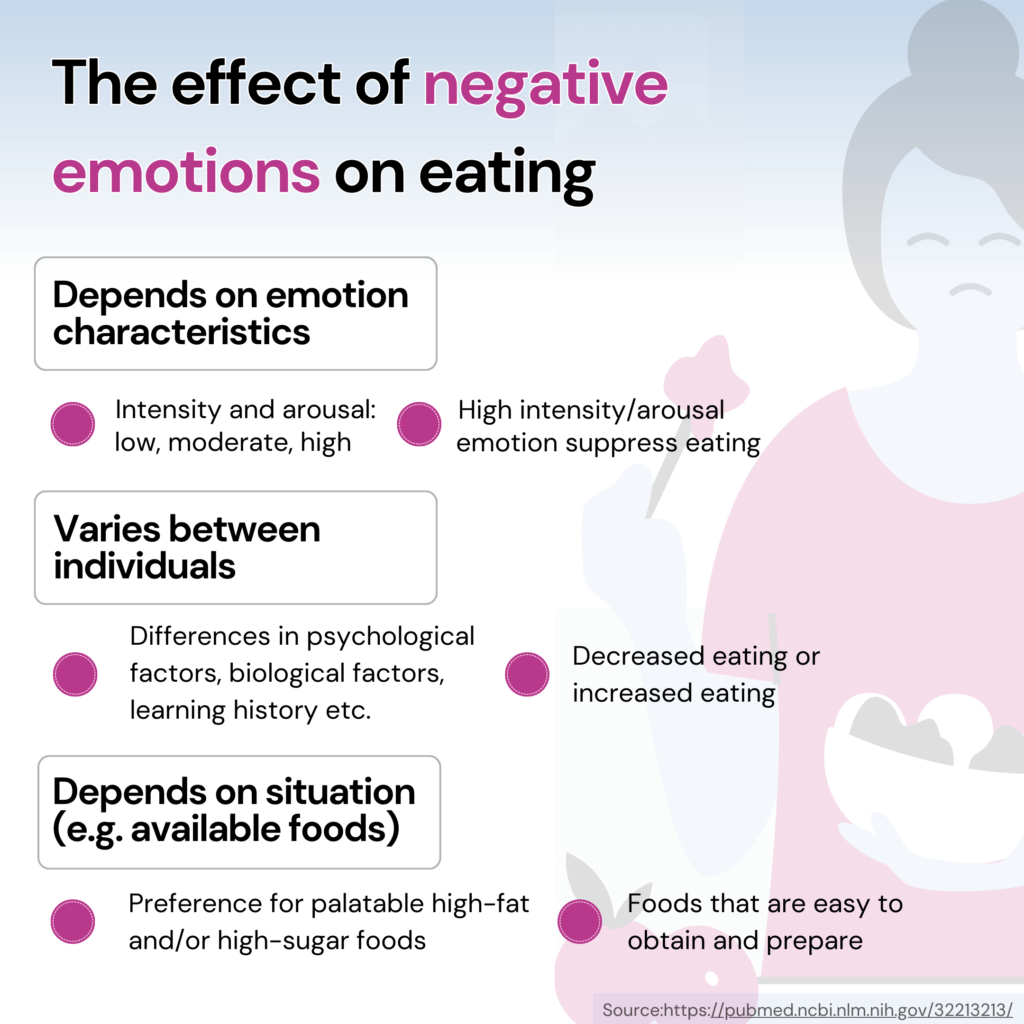
Certain mental health problems can lead to overeating, which may worsen mental illness symptoms.
This cycle can get destructive when left unchecked.
The following are some of the dangers of overeating.
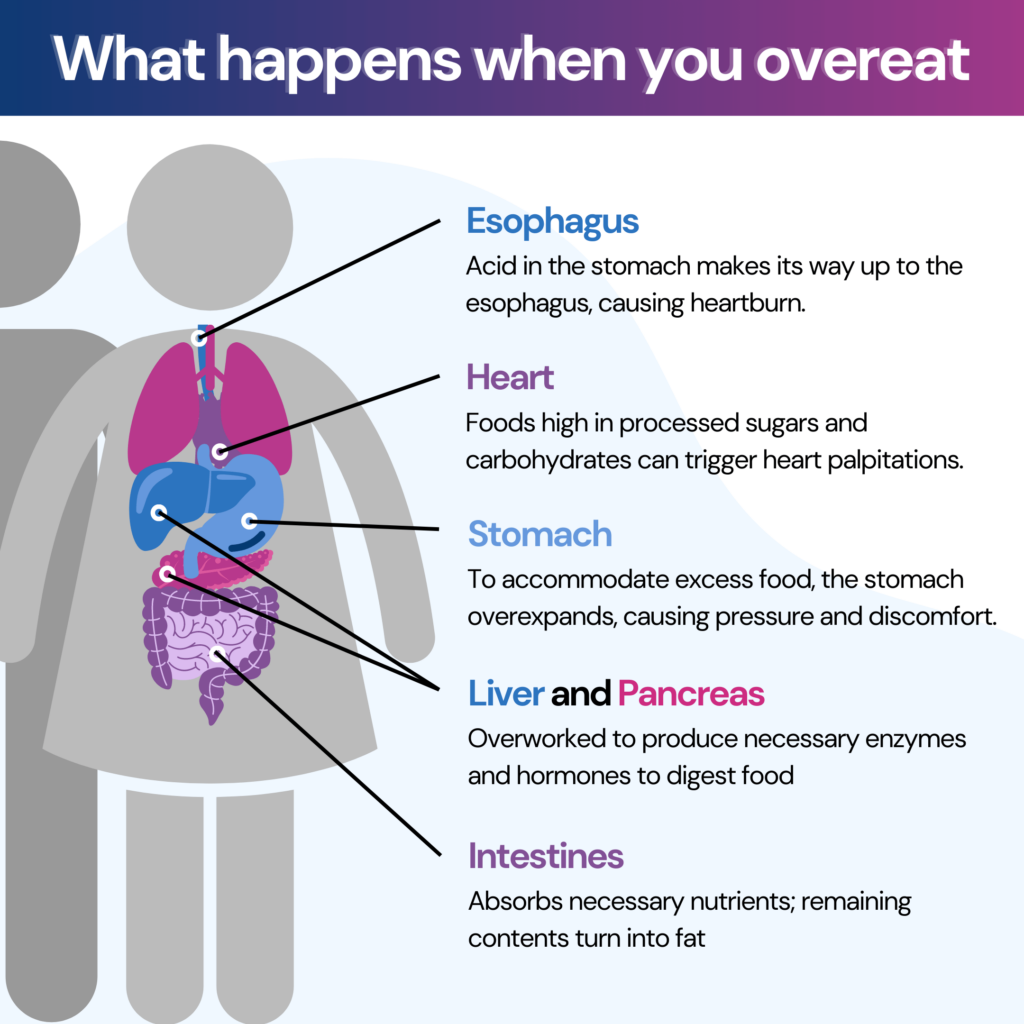
According to science, any internal or external stimulus that creates a biological response in the body is called stress.
Depending on the type and intensity of stress, the biological responses can vary from increased breathing to even life-threatening symptoms.
A controlled study reports that stress is an essential precursor of emotional eating disorders.
A recent study published in the Neuron analyzes the relationship between chronic stress and emotional eating habits.
It reports that stress drives emotional eating and encourages people to choose palatable food that may lead to weight gain.
A group of researchers published a study in June 2023 that analyzed the effects of stress on eating habits.
According to experts, lateral habenula (LHb), a small structure of the brain, increases the pleasure of eating while stressed.
This structure expresses neurons that encourage hedonic feeding under stress.
Hedonic feeding is the act of consuming food for pleasure without being hungry.
Biohacking Important Genetic Driving Factors For Emotional Eating
In this study, the researchers exposed rats and mice to stress treatment.
Initially, these rats experienced low appetite and anxiety-like symptoms.
When the rats and mice were shown highly palatable food choices (foods rich in carbohydrates, sugar, and fat), their appetites quickly increased.
The animals started adapting to comfort eating and started consuming foods in excess.
Their energy expenditure also became minimal.
As a result, soon, the animals turned obese.
Generally, the brain sends signals of satiety (the feeling of being satisfied or full after a meal) when the body has had enough to eat.
When people continue to eat after feeling sated, the pleasure of eating starts diminishing.
This study reports that stress overrides the feeling of satiety and hence promotes overeating.
Chronic stress also overrides the diminishing pleasure feeling after eating a hearty meal.
Hence, the more the person eats, the more pleasure is built.
This also leads to overeating.
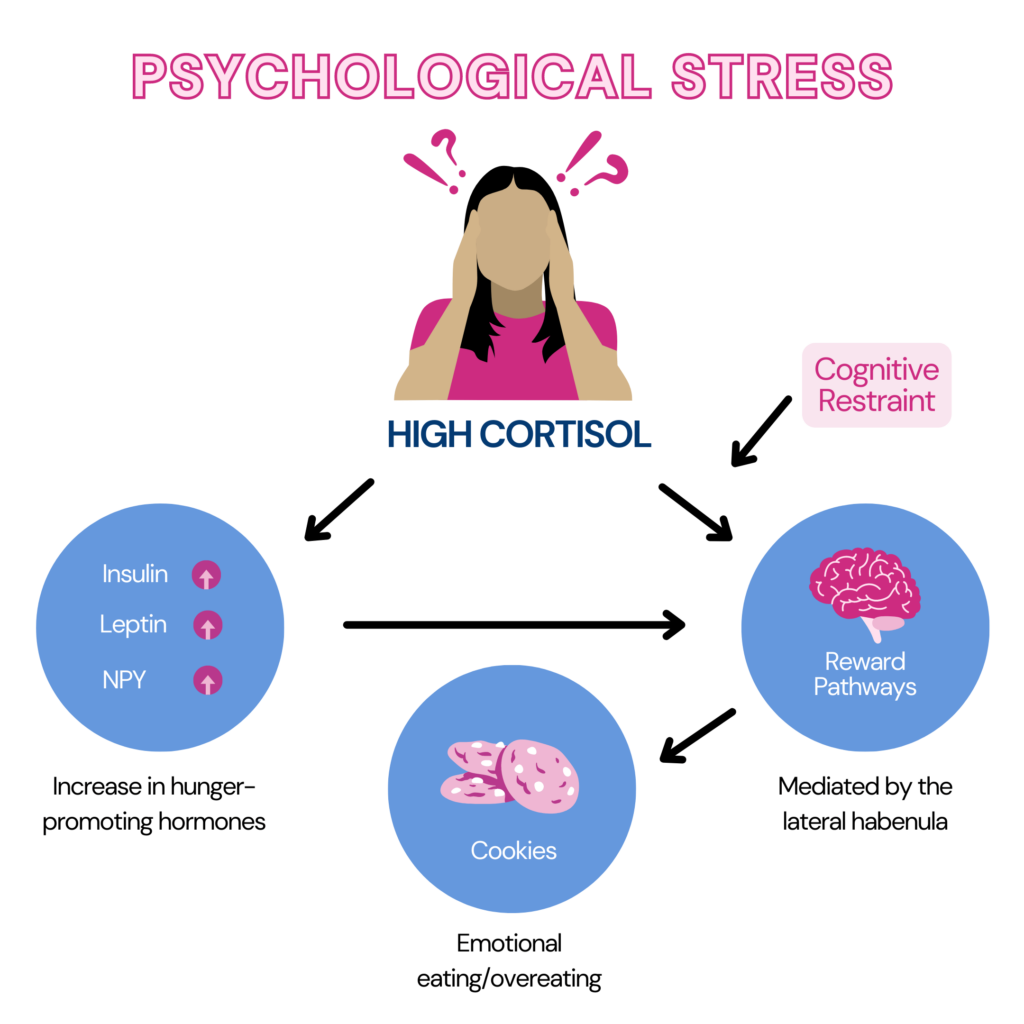
Sweet foods are the go-to options for anyone who indulges in emotional eating.
Scientists believe there is a reason for this.
A study published in the Journal of Clinical Endocrinology and Metabolism reports that sugar reduces the stress response in the brain.
This study conducted stress tests in two groups of women for two weeks.
Researchers offered one group of women sugary drinks three times a day, and the other group drinks with a sugary substitute (aspartame).
Before and after the study, the activities in their hippocampus regions were monitored.
The researchers also measured the participants' cortisol (stress hormone) levels.
The study reports that sugar decreased cortisol levels and changed hippocampus activities significantly.
Grabbing a sweet treat before an examination or after a breakup could be the body’s way of bringing down the effects of stress.
Calories from food and beverages are the primary source of energy for the body.
Food and beverages help store energy in the body, and physical activities help burn the stored energy.
Energy balance is finding a balance between the calories consumed and burnt.
A healthy energy balance denotes not having excess calories remaining in the day.
Excess of remaining calories leads to weight gain and obesity.
Stress may encourage people to choose highly palatable food regularly.
High-palatable foods are often rich in carbohydrates, sugar, and fat and are calorie-rich.
Overeating and stress can cause other mental health conditions like depression and low energy levels.
All of these can bring down the ability to be physically active.
A combination of overeating and low physical activity can lead to energy imbalance.
During acute stress, eating more food may help the body deal with the stressful situation and provide the brain with more energy to function.
However, most cases of stress right now are chronic (long-term).
That’s why emotional eating ends up causing more damage to the body and brain over time.
Overeating may provide a temporary solution to handling stress, but the aftereffects of overeating may worsen the existing mental state and cause more significant problems.
Knowing how stress and overeating are related may help healthcare professionals handle these conditions better.
Offering ways for emotional regulation and providing professional help for building emotional well-being can all prevent eating disorders in people of all ages.
Obesity and overeating are two primary preventable conditions causing global governments billions of dollars in healthcare expenses.
Experts may be able to develop targeted interventions for weight gain and overeating by focusing on the emotional states of people in need.
The following are ways to gain control of emotional eating.
Here's how you can still get your nutrition report
https://www.sciencedaily.com/releases/2023/06/230608120905.htm
https://pubmed.ncbi.nlm.nih.gov/32213213/
https://ijbnpa.biomedcentral.com/articles/10.1186/s12966-019-0791-8
https://sci-hub.ru/10.1017/S0029665120000166
https://www.ncbi.nlm.nih.gov/pmc/articles/PMC7916829/
https://pubmed.ncbi.nlm.nih.gov/28292531/
https://www.ncbi.nlm.nih.gov/pmc/articles/PMC3357460/
https://pubmed.ncbi.nlm.nih.gov/28900385/
https://pubmed.ncbi.nlm.nih.gov/16868274/
https://sci-hub.ru/10.1097/01.psy.0000227749.58726.41
https://sitn.hms.harvard.edu/flash/2015/ask-the-brain-why-do-we-crave-sugar-when-were-stressed/
https://www.sciencedirect.com/science/article/pii/S2352154616300183
https://www.nhlbi.nih.gov/health/educational/wecan/healthy-weight-basics/balance.htm
Have you ever had trouble maintaining attention and alertness throughout the day, particularly in the afternoon slump? Many people frequently experience the need for an instant energy boost. An innovative "coffee nap" strategy has lately become well-liked as a productive approach to reduce tiredness and increase productivity. But does science support this pattern, or is it only a passing trend?
In this following piece of writing, we will learn about its benefits and find out if it's a temporary fad or a proven method for recharging our minds and bodies.
Do Your Genes Favor Coffee Naps? Find Out With The Nutrition Report!
A cup of coffee before a quick doze is known as a coffee nap.
To maximize the rejuvenating effects, combining caffeine and 15 to 20 minutes of sleep will be helpful.
A caffeinated beverage, like coffee, is often consumed first (it takes the body around 20 minutes to start working), then 15 to 20-minute sleep.
According to research, caffeine plays an important role in clearing out chemicals, like adenosine, which is responsible for making a person sleep.
We must look at sleep and caffeine systems to understand the science behind th.
Adenosine is a neurotransmitter that encourages sleep and relaxation, leading to tiredness and a desire for sleep.
On the other hand, caffeine stimulants can attach to the brain's adenosine receptors, reducing their activity and enhancing alertness.
When we take caffeine, it fights with adenosine to reduce adenosine's sleepy effects. However, the process takes time.
Caffeine typically takes 20 minutes to reach its peak blood-level concentration. This is also the recommended duration for a coffee nap.
During a short nap, the brain undergoes various stages of sleep, including light sleep and potentially entering into the initial stages of deep sleep.
This short snooze can provide therapeutic benefits, such as reducing sleep inertia and increasing cognitive function upon waking.
Combining caffeine consumption with a nap can synchronize the effects of caffeine and sleep, resulting in a more alert and refreshed state upon waking up.
Caffeine starts to work as soon as the individual wakes up, reducing the building of leftover adenosine and boosting energy levels.
While the idea of coffee naps might appear in conflict, there is emerging scientific evidence to support their effectiveness.
Numerous research has looked into how sleeping after consuming caffeine affect alertness, cognitive function, and mood, shedding light on the underlying mechanisms.
A study was conducted in Japan using a sample of 10 participants.
One group (group A) had coffee before taking a 20-minute nap, and the other didn’t (group B).
Group A showed notably better performance than Group B.
Another study was conducted on a sample of 12 individuals with a history of sleep deprivation.
They were subjected to 200 mg of caffeine before a 15-minute nap.
The study reported that the coffee nap resulted in a 91% lower rate of drowsiness while engaging in a two-hour driving simulation.
(in comparison to those who weren’t subjected to it)
This statement remains valid even in cases where individuals weren't involved in actual sleep during their assigned nap time but stayed in a state of partial wakefulness.
Coffee naps during work hours may also be helpful to people working the night shift.
According to research conducted on shift workers, coffee naps helped improve alertness and performance in cognitive tasks like quick thinking and prolonged focus.
In addition, following a coffee nap, participants reported feeling more awake, less worn out, and happier.
How Genes Regulate The Effects Of Caffeine On Sleep
Coffee naps offer several potential benefits beyond regular naps or caffeine consumption alone. Here are some of the key advantages:
It's important to remember that every person will experience and react to coffee naps differently.
For example, while many people report satisfying results, others may discover that the effects are milder or that they have trouble sleeping after consuming coffee.
Therefore, it's recommended to experiment and assess how coffee naps work for you personally, considering factors such as caffeine sensitivity and individual sleep patterns.
While coffee naps offer unique benefits, they only suit some in some circumstances.
Regular naps, without caffeine, can still provide relaxation and rejuvenation.
However, some individuals may have sensitivity to caffeine or experience sleep disruptions if consumed too close to bedtime.
Therefore, it is essential to consider personal preferences, tolerance to caffeine, and sleep patterns when deciding whether to add coffee naps into one's routine.
Genetics can influence how our bodies process caffeine and the effects of coffee naps.
For example, the CYP1A2 gene produces an enzyme the liver uses to metabolize caffeine. As a result, changes in this gene may impact how quickly the body breaks down coffee.
Coffee naps may be more advantageous to individuals who slowly metabolize caffeine because they will likely feel the stimulant's effects for extended periods.
On the other hand, fast metabolizers could break down caffeine more rapidly, producing effects that last less time.
The reaction to coffee naps can also be affected by additional genetic variables and individual variances, such as caffeine sensitivity and general sleep quality.
To make the most out of this method, you can follow these steps:
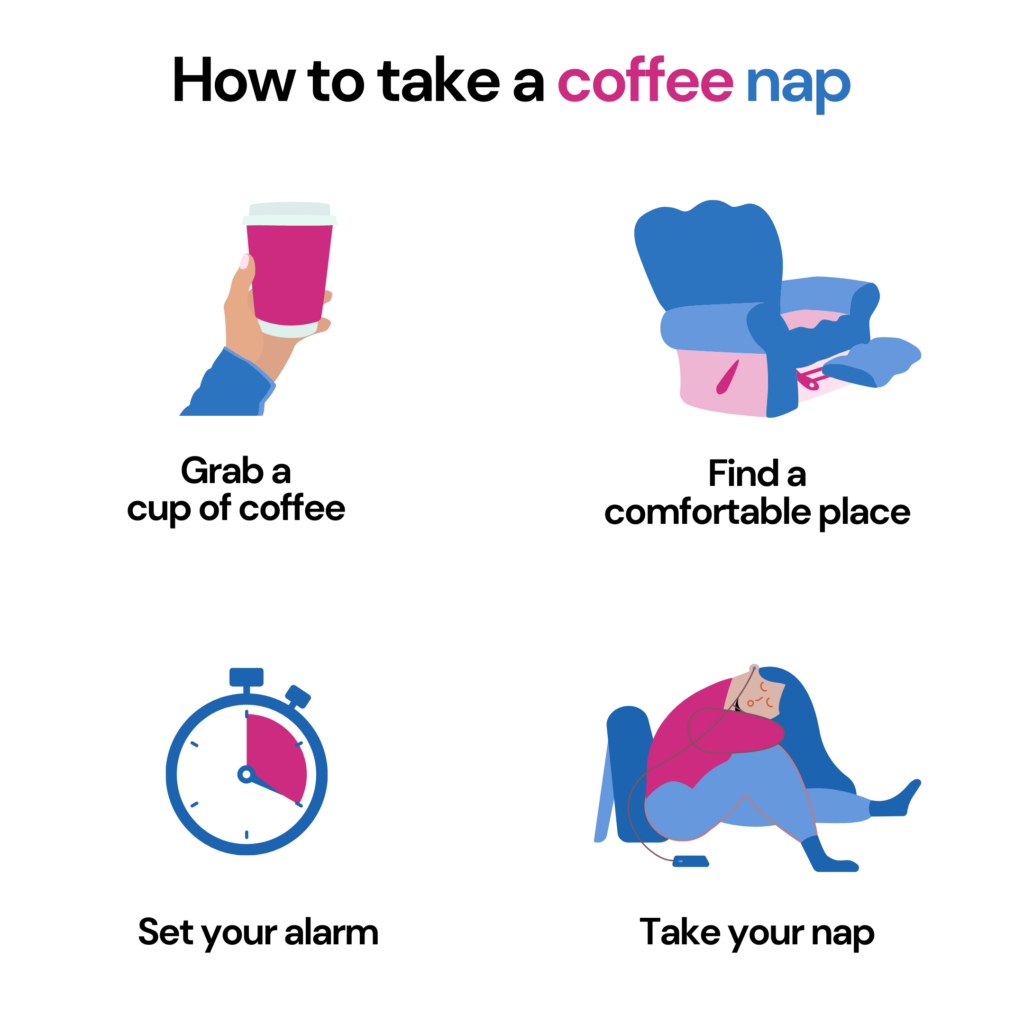
People looking for an instant energy boost and better productivity have become interested in coffee naps.
Coffee naps provide a novel method of overcoming sleepiness and boosting alertness by combining the benefits of caffeine and a short snooze.
According to scientific studies, taking a nap after caffeine intake may promote mood, enhance cognitive function, and even help memory consolidation.
However, while assessing if this method is appropriate, consideration should be given to personal preferences, caffeine metabolism, and individual differences.
Coffee naps may not be a one-size-fits-all solution, but they may be useful when a little boost in alertness and energy is needed.
As with other sleep-related practices, it is essential to put overall healthy sleeping habits first and ensure you receive sufficient rest.
https://www.healthline.com/nutrition/coffee-nap
https://www.ncbi.nlm.nih.gov/pmc/articles/PMC5337178/
https://www.sciencedirect.com/science/article/abs/pii/S1388245703002554
https://pubmed.ncbi.nlm.nih.gov/9401427/
https://pubmed.ncbi.nlm.nih.gov/16453980/
https://www.ncbi.nlm.nih.gov/pmc/articles/PMC2603066/
https://www.ncbi.nlm.nih.gov/pmc/articles/PMC3346273/
Persistent fatigue, abdominal discomfort, or unexplained changes in appetite are just some symptoms that can signal underlying liver health issues.
When it comes to liver diseases, understanding the genetic factors involved is crucial.
In this blog post, we shed light on the top three genetic liver diseases of 2023, unraveling the connections between genetics and common symptoms that impact daily life. Read on to learn more!
Certain genes don’t directly cause diseases but contribute to increased risk. Triggered by certain environmental or lifestyle events, this risk can translate into disease development. Learning about these genes can help modify lifestyle factors to reduce your risk or even prevent the conditions. Learn more:
Genetic liver diseases are a group of genetic and metabolic defects that can result in chronic liver disease.
While some people inherit these conditions from their parents or close relatives, others are born with abnormal changes (or mutations) in their genes.
The prevalence of genetic liver diseases is variable, and they are considered rare diseases.
Hemochromatosis is a genetic liver disease in which iron begins to collect in the liver and other organs.
Primary hemochromatosis is one of the most common inherited diseases in the US.
When one family member has this disorder, their siblings, parents, and children may be at risk.
Secondary hemochromatosis is not genetic and is caused by other diseases like thalassemia.
Iron overload associated with hemochromatosis affects men more commonly than women.
Due to menstruation, women are not likely to show signs of iron overload until menopause.
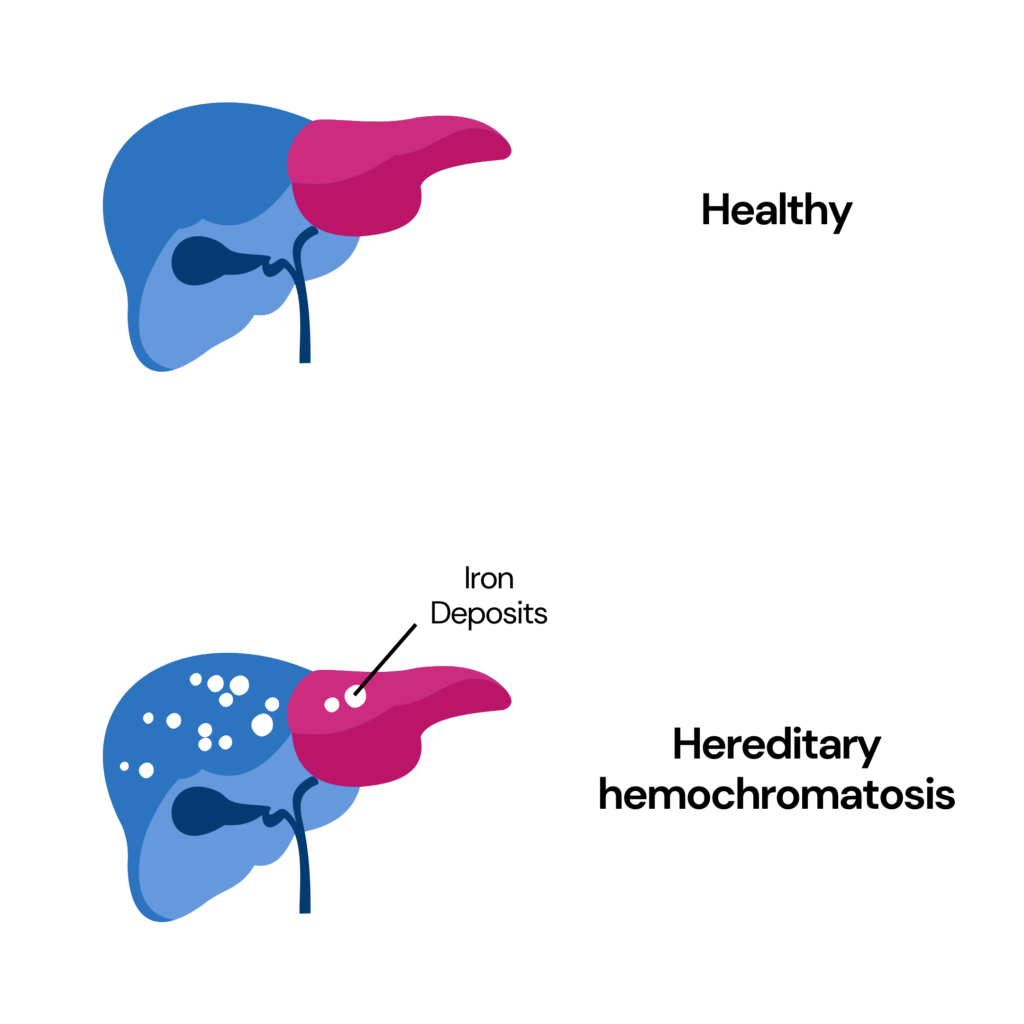
Symptoms and Treatment
A few common symptoms of hemochromatosis include:
People with hemochromatosis may also show signs of diabetes and heart disease.
Treatment for hemochromatosis includes one of the following:
Alpha 1 antitrypsin deficiency, or AATD, is an inherited genetic condition that affects 1 in 1,500 to 3,500 individuals of European ancestry.
This condition affects the lungs and liver.
Alpha-1 antitrypsin is a protein that protects the lungs from damage due to infection-fighting components released by the immune system.
When this protein is too low or damaged, the lungs are affected, leading to breathing difficulty and conditions like emphysema.
People with this condition also risk developing cirrhosis due to the accumulation of alpha-1 antitrypsin.
In the lungs, AATD causes emphysema, whereas, in the liver, it causes the accumulation of abnormal alpha-1 antitrypsin, leading to progressive liver injury.
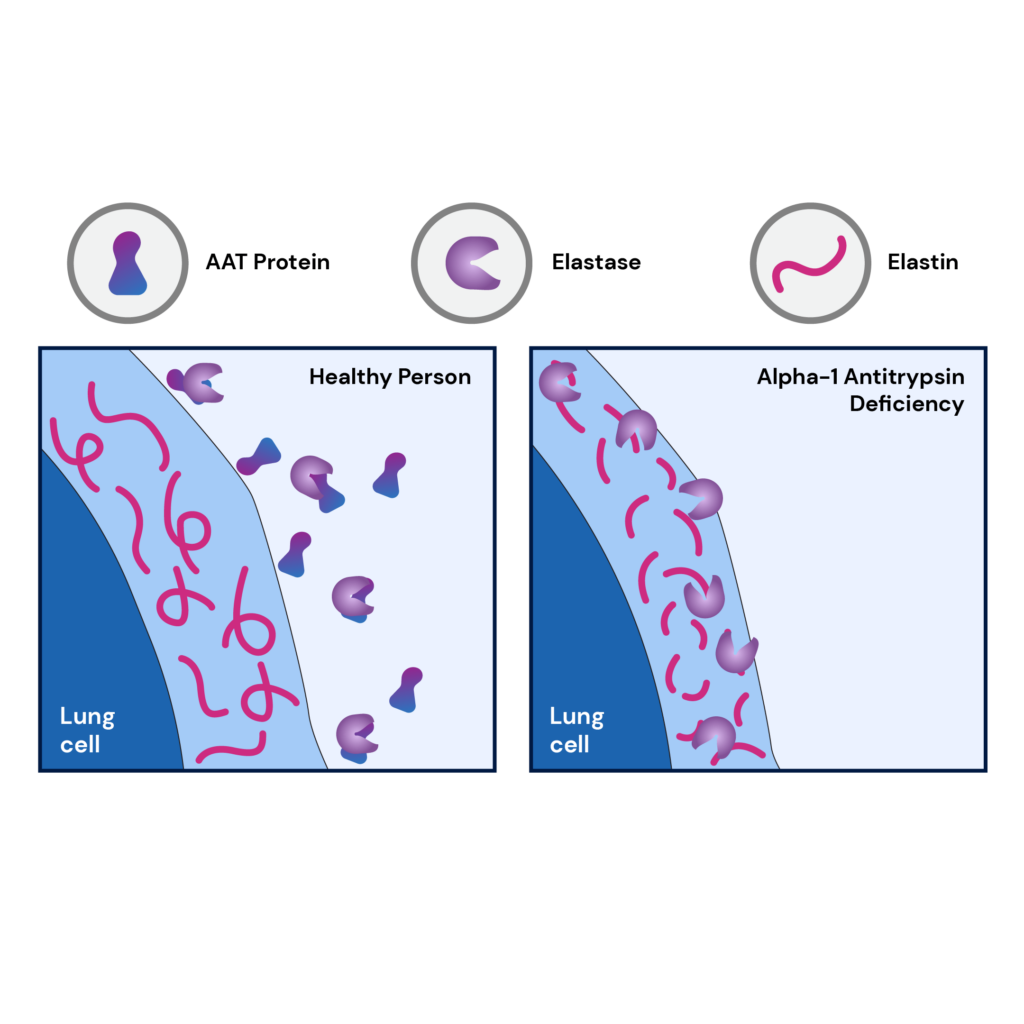
Symptoms and Treatment
One of the first symptoms of AATD is usually those which affect the lungs.
Common symptoms of AATD include:
Currently, there is no established treatment to cure AATD.
While replacing the defective protein in the bloodstream may be done, experts need clarification about how effective this procedure will be.
Most often, treatment of AATD includes the management of emphysema and cirrhosis.
Other treatments may include:
People with AATD can undergo a liver transplant if they don’t have lung disease.
Wilson's disease is a genetic disease caused by mutations in the ATP7B gene and results in an increased accumulation of copper in the body.
This is a rare disease and affects 1 in 30,000 individuals.
Wilson's disease does not cause any symptoms unless it is serious.
It can be diagnosed using blood and urine tests, liver biopsies, and genetic tests.
The aim of treating Wilson's disease is to remove the excess copper in the body and prevent reaccumulation.
Symptoms and Treatment
Common signs and symptoms of Wilson’s disease are:
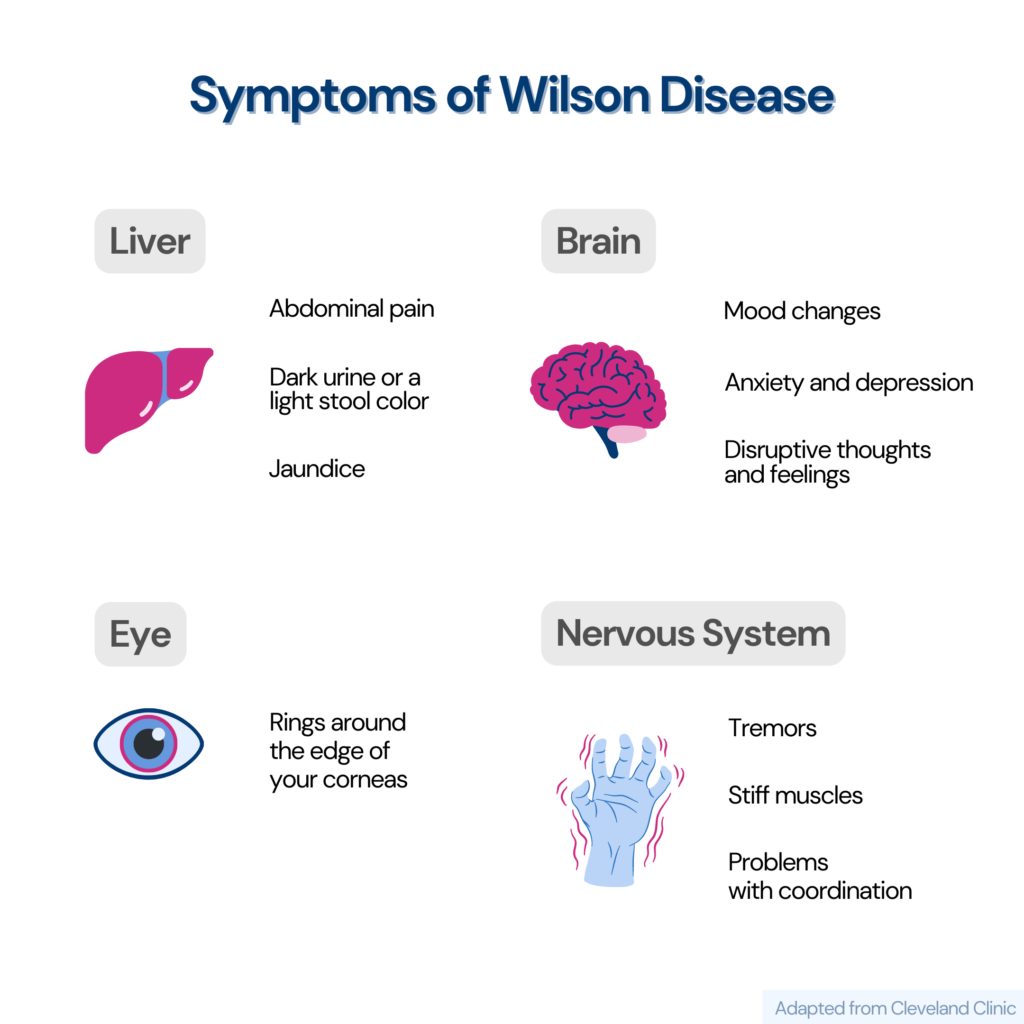
The treatment of Wilson’s disease includes one or more of the following:
Genetic testing is recommended for individuals with liver diseases like bile acid synthesis defects, jaundice, and cholestasis with unknown causes.
A liver genetic test usually involves sequencing or deletion/duplication analysis.
Before a genetic test for liver disease is performed, your doctor may recommend the following tests:
To undergo genetic testing for liver disease,
In some cases, a blood test may be followed by a liver biopsy to interpret the test results better.
A few genes that are routinely tested for genetic liver disease are:
Some direct-to-consumer genetic testing companies provide the option to learn your risk for liver diseases.
These tests are non-invasive and don’t diagnose genetic liver diseases. However, they present you with a comprehensive risk profile for liver diseases.
This information can then be used to reduce your risk and enable early screening and detection.
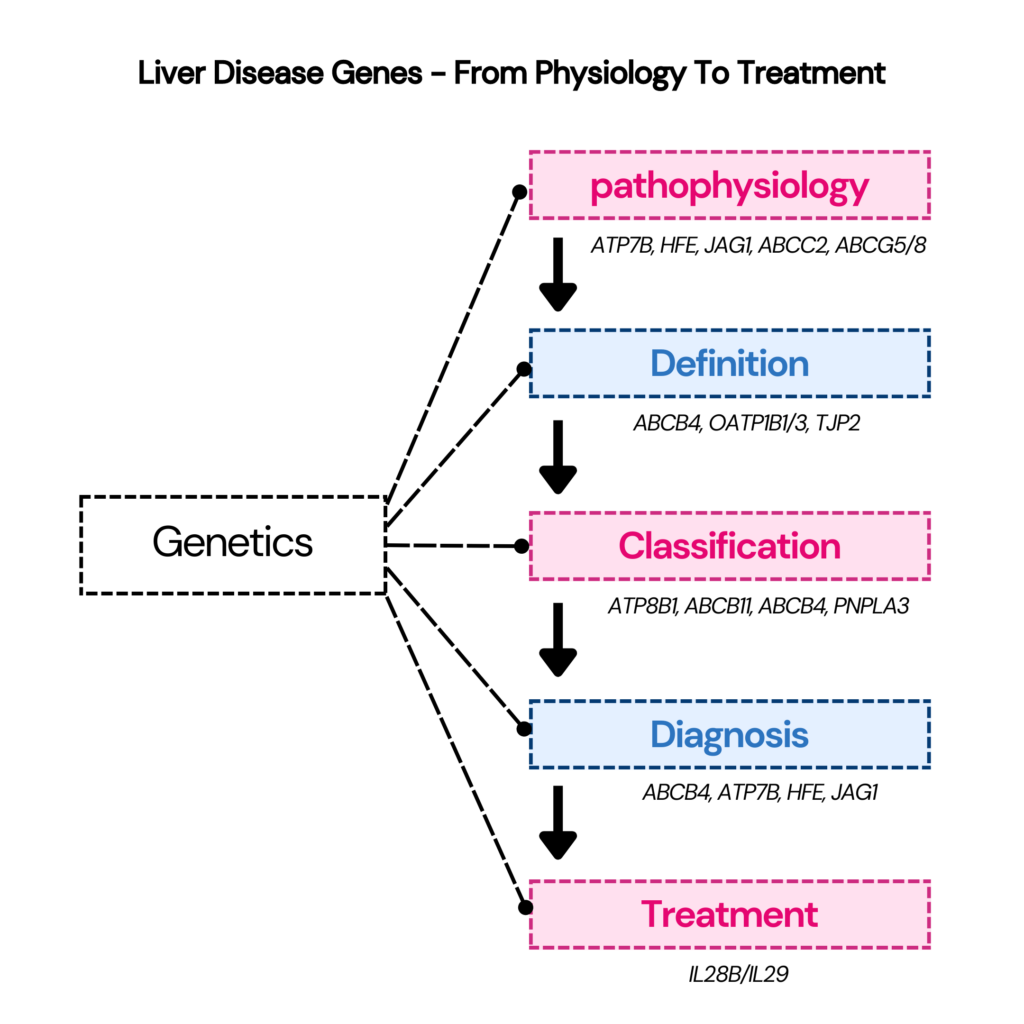
Liver Disease Parameters in Xcode Life’s Health Panel
Check Out The Gene Health Panel Here
There are several tests available for diagnosing genetic liver diseases. However, these tests have their limitations.
Genetic testing is most useful for diseases like hereditary hemochromatosis due to the high frequency of C282Y mutations in people of European descent.
In the case of other genetic liver diseases, testing is less helpful as they have a higher number of possible mutations and clinical manifestations.
Appropriate use of screening tests can help in the early detection of genetic liver diseases and prevent end-organ damage.
However, genetic testing for liver diseases cannot prevent the development of the disease.
Unlock the secrets to a better night's sleep by understanding the fascinating interplay between your menstrual cycle and sleep.
As a woman (or people assigned females at birth), your monthly cycle influences more than just your physical and emotional well-being.
It can significantly impact the quality of your sleep.
Each phase of your menstrual cycle brings unique changes to your body that can affect your sleep patterns.
This article delves into the intricate relationship between your menstrual cycle and sleep, exploring how different phases can disrupt or enhance your rest.
We also provide practical tips to optimize your sleep throughout your cycle.
Did You Know? While external factors impact your sleep health, internal factors like your genes can also influence how well you sleep. Certain genetic differences can result in poor sleep quality and an increased risk for sleep disorders. Learn more:
There are four stages in the menstrual cycle:
| Phase | Description | Days* | Hormone changes |
| Menstrual phase | Menstruation, the initial phase of the menstrual cycle, involves the shedding of the uterine lining. This 3 to 7-day process occurs when the egg is unfertilized, eliminating the mucous layer through the vagina, though the duration may differ among individuals. | Day 1 - Day 5 | Estrogen and progesterone level drops |
| Follicular phase | Follicles develop on the surface of the ovary, with one mature to form an egg. 6th day after menstruation until ovulation. Women with regular cycles have this phase for around 6-8 days. | Day 6 - Day 11 | Estrogen levels rise, and low progesterone levels |
| Ovulation phase | Release of an egg/ovum from one of the ovaries. Women with normal cycles have this phase for around 5-7 days. | Day 12 - Day 16 | Estrogen levels start to decrease, and progesterone levels start to increase |
| Luteal phase | The luteal phase lasts around 8-11 days in regular cycles. Hormonal changes during this phase may lead to mood swings, headaches, acne, bloating, and breast tenderness - common signs of premenstrual syndrome (PMS). If fertilization doesn't occur, the menstrual cycle repeats from the beginning. | Day 17 - Day 28 | Higher progesterone (declines as the luteal phase approaches an end) and lower estrogen levels |

Women experience sleep disturbances more frequently than men.
One of the factors contributing to this could be the menstrual cycle.
According to a study, young women who reported sleeping less than 8 and 7 hours per day experienced more premenstrual spasms than those who slept for 8 hours or more.
Sleep disturbances tend to increase during the premenstrual and menstruation phases, particularly in women with PMS and dysmenorrhea (painful menstrual cramps).
This could be attributed to hormonal changes involving progesterone and estrogen.
The effects of the changes are more notable in the premenstrual phase.
Women diagnosed with polycystic ovary syndrome might encounter sleep problems due to the following factors:
Is Obstructive Sleep Apnea Genetic?
Compared to the follicular phase, the luteal phase results in a body temperature rise of about 0.3°C to 0.7°C.
This sudden temperature change creates disturbed sleep quality.
A study also associates higher body temperature with reduced REM sleep in the luteal phase.
Therefore, hormonal fluctuations throughout the menstrual cycle alter temperature regulation, affecting sleep quality.
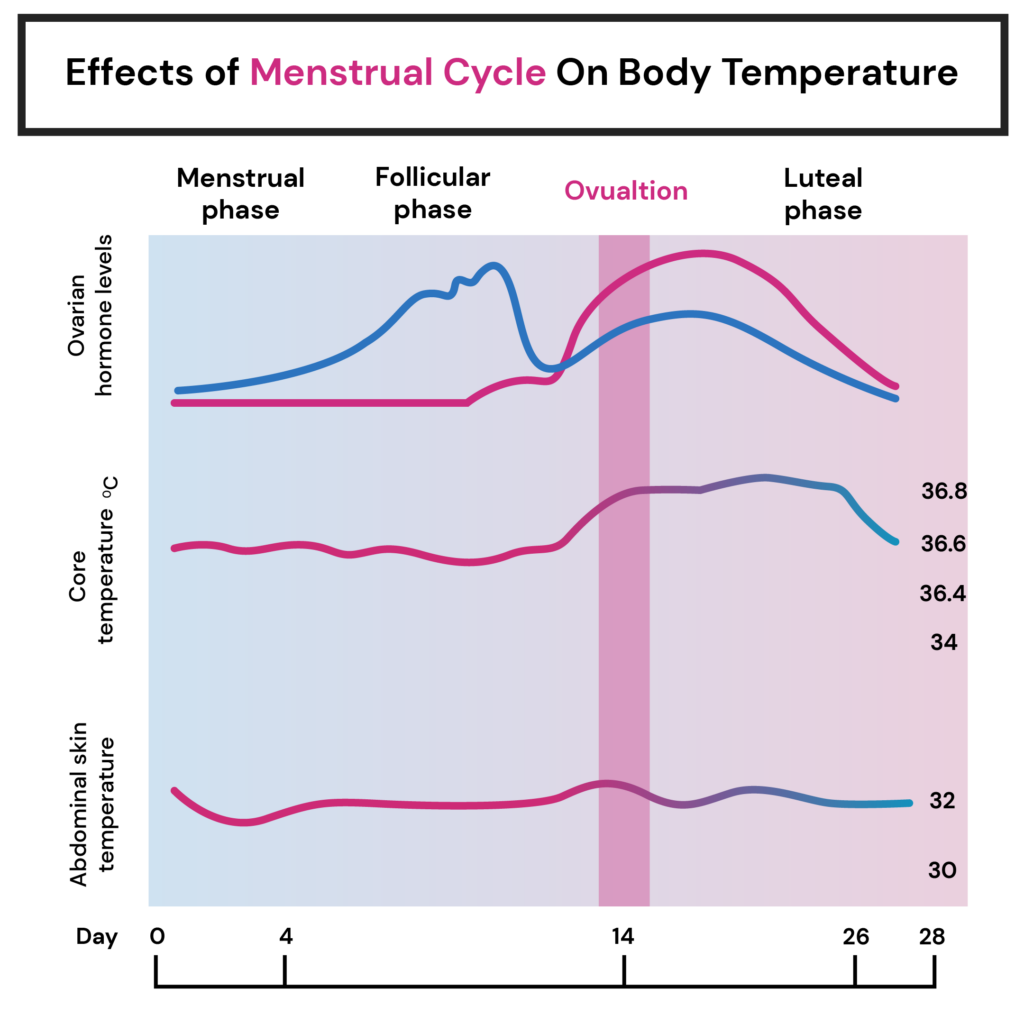
Higher progesterone (declines as the luteal phase approaches an end) and lower estrogen levels during the luteal phase prevail if the egg is not fertilized.
A 2016 study published in the Journal of Sleep Medicine and Disorders investigated the relationship between sleep and PMS.
It reported the following:
Females who experience premenstrual syndrome are more likely to have insomnia.
As a result, they experience excessive daytime sleepiness, reduced focus, and concentration, and are tired and drowsy throughout the day.
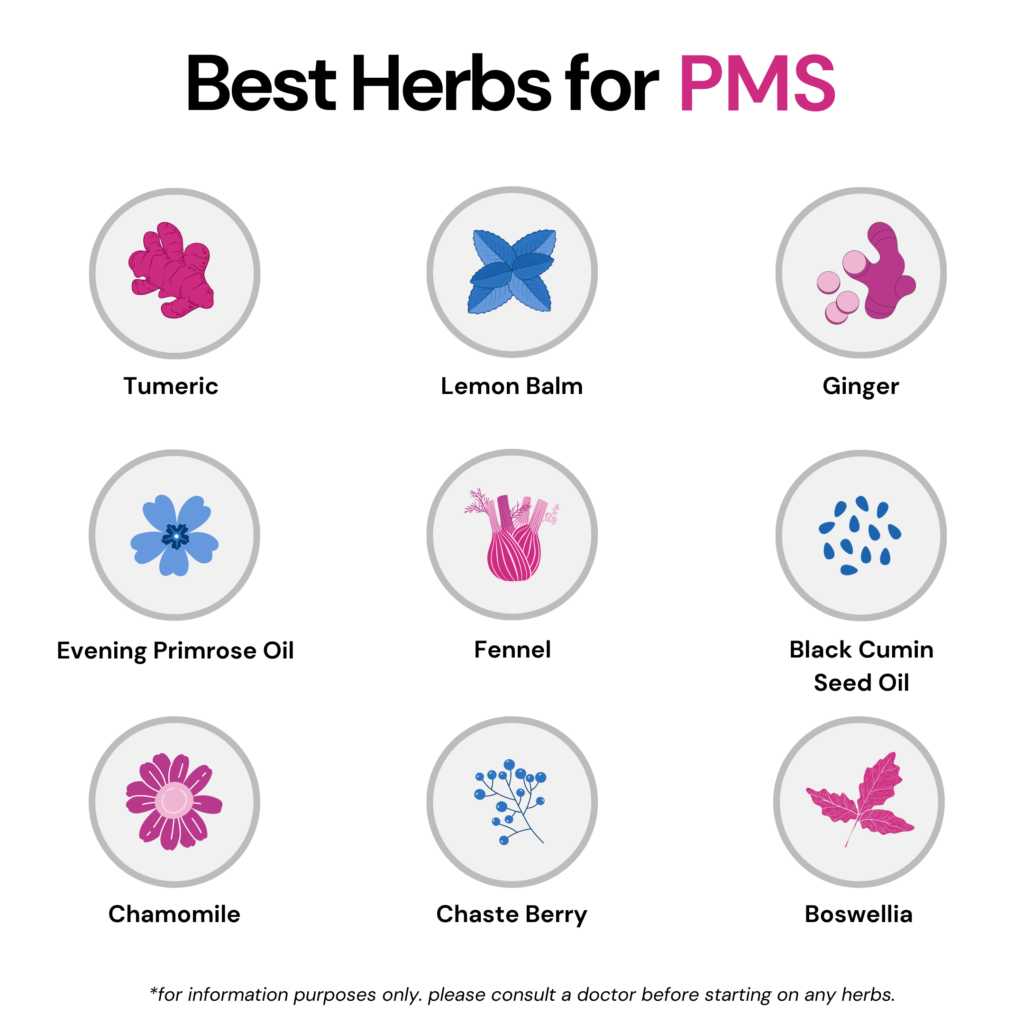
Women experience more sleep problems than men, with one of the key factors being hormonal fluctuations during their menstrual cycle.
Hormonal fluctuations alter the temperature range, which also impacts sleep quality.
Sleep problems are more evident in the luteal (premenstrual) and menstrual phases than in others due to reduced melatonin and allopregnanolone levels and menstrual cramps.
Sleep quality can be improved by incorporating natural remedies, practicing relaxation techniques, implementing pain management strategies, reducing caffeine consumption, and avoiding exposure to blue light.
Please consult a qualified healthcare practitioner if you experience severe sleep disturbances or other menstrual cycle-related problems.
Here's how you can still get your sleep report